Albert Perruche, born in Avignon (Vaucluse) on June 7, 1891, is listed under matricule 6745 in the Dictionnaire des élèves architectes de l’École des beaux-arts de Paris (1800-1968). He was a student at the École régionale d’architecture de Marseille in December 1911 and was admitted to the second class at the École des beaux-arts de Paris on July 30, 1912.
A humoristic 22 pages manuscript short essay on watercolor painting by Albert Perruche 6.5×8.25 inches. Front cover designed ans signed by Perruche simply titled “La peinture a l’eau”, in exceptional condition.
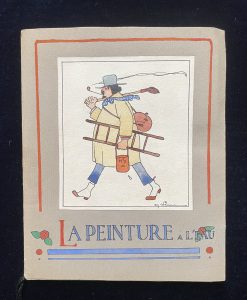
La peinture à l’eau, dite aquarelle, à l’usage des gens qui désirent la faire en amateurs pour passer le Premier Mai, les Dimanches et les Lundis de Pâques et de Pentecôte, par un qui la fit sans Maître, 1919.

Watercolor Painting, also called aquarelle, for the use of those who wish to practice it as amateurs to pass the time on May Day, Sundays, and the Mondays of Easter and Pentecost, by one who did it without Master, 1919.
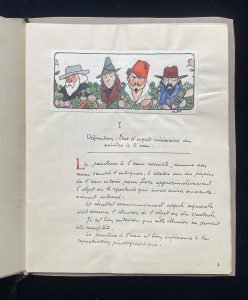
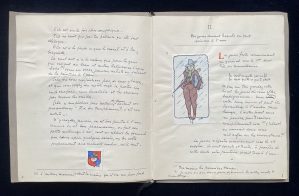
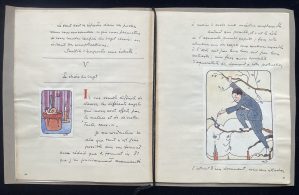

Sold together with the manuscript are three important documents from Albert Perruche concerning his time as a soldier during WWI.
A letter signed by Perruche, written from Paris on Bastille Day (July 14, 1915), expresses gratitude for a received letter and packages, mentions a patriotic day immersed in the Republic’s celebrations, and discusses upcoming departures and social visits. The hand-drawn illustrations add a personal and patriotic touch to the message.

The rest of the letter mentions hospital transfers and potential routes for his return, listing Paris, Le Mans, Tours, Lyon, Limoges, Toulouse, and Montpellier. He refers to a “distribution of sketches” and humorously comments on the recipient’s possible reaction to his letter.
He closes with a patriotic tone, sending “Republican kisses” and signing as “Le poilu” (a common term for French soldiers in WWI) and “Diable noir” (Black Devil, possibly a nickname or unit reference).
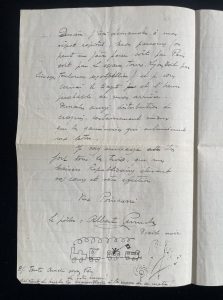 A two page list that is probably for drawings or photographs of places and actions during WWI.
A two page list that is probably for drawings or photographs of places and actions during WWI.
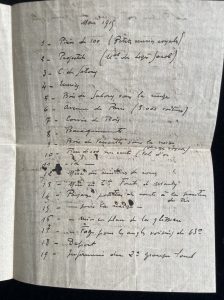
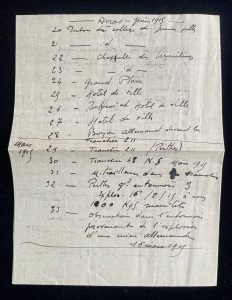
A long list documenting the extensive military service record of Albert Perruche, listing cantonnements (stationing locations) from 1912 to 1919, covering both military service and wartime deployments. It includes locations in France, Belgium, and possibly other areas during World War I, along with dates, units, and remarks on movements, assignments, and engagements.

Perruche’s 10th Foot Artillery Regiment (10th RAP) is a former regiment of the French army, created in 1910 from the 10th Foot Artillery Battalion, which itself originated from the 10th Fortress Artillery Battalion created in 1883. The 10th RAP was dissolved on December 31, 1919, the same year Perruche was discharged.
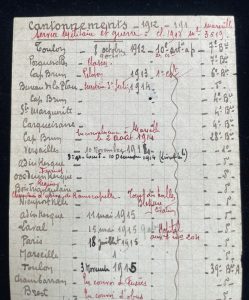
It records movements from military service to wartime locations, including notable places such as Toulon, Marseille, Paris, Versailles, and the Western Front in Belgium (Asinkerque, Oostdunkerque, Nieuport, Furnes, Ramscapelle). There are mentions of being wounded (“blessé”) and cited for recognition (“citation”) at Ramscapelle. Later entries include transport assignments involving fuses (“fusées”) and shells (“obus”).
Some notable entries include:
Early service (1912-1914): Toulon, Marseille, Versailles.
World War I (1914-1918): Various deployments, including Flanders (Asinkerque, Nieuport, Ramscapelle, Furnes), major battle zones, hospitals, and supply transports.
Post-war (1918-1919): Movement through occupied territories, involvement in the armistice period, and final discharge on August 13, 1919, in Marseille.
The document contains handwritten notes in black and red ink, indicating citations, injuries, and logistical movements, with some sections underlined or marked for emphasis. This detailed personal log provides a firsthand account of a soldier’s service throughout the war.
 This is a remarkable historical document, providing a detailed first-hand account of a French soldier’s service throughout World War I.
This is a remarkable historical document, providing a detailed first-hand account of a French soldier’s service throughout World War I.
